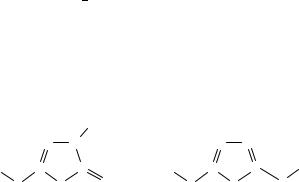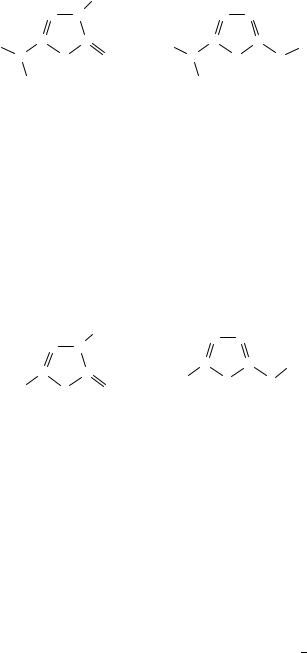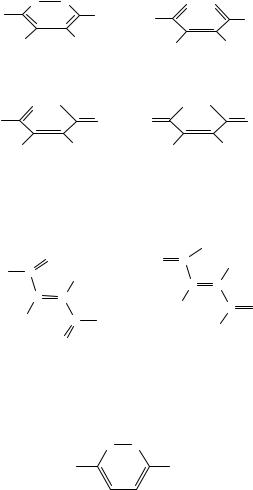

|
|
|
23. The thiocarbonyl group |
|
1385 |
||
|
|
S |
|
|
|
S |
H |
|
|
|
|
|
|
||
|
H |
C |
N |
|
|
C |
N |
|
|
|
|
||||
|
N |
|
|
N |
|
||
|
|
C |
|
|
C |
||
|
|
|
C |
H |
|
|
C H |
H |
C |
|
C |
H |
C |
|
C |
|
N |
N |
N |
|
N |
N |
N |
|
|
|
|
||||
|
H |
|
H |
|
H |
|
H |
|
|
|
|
|
|
||
|
|
(25c) |
|
|
|
(25d) |
|
considered in the work of Leszczynski), which is predicted to be 3.4 kcal mol 1 more stable than the thione form 25a. Also significantly, the thiol tautomer 25b is found to be also much more stable (2.5 kcal mol 1) than the thione form 25a.
These discrepancies were explained in terms of the differences between the optimized geometries used36. Another important conclusion in the work of Alhambra’s group36 is that water has a dramatic effect on the charge distribution of 6-thioguanine leading to important changes in the tautomer population, where only thione tautomers 25a and 25c should be found. Protonation of 6-thioguanine in the gas phase yields the 25e thione form as the most stable species, although the 25f thiol tautomer is very close in energy. Protonation in aqueous solution, where the N1(H) thiones are the main tautomers, occurs at the free imidazole nitrogen, leading to the most stable protonated tautomer 25e. Finally, it must also be indicated that the AM1 semiempirical method fails to reproduce129 the stability order predicted by high level ab initio calculations. Hence, the conclusions of Contreras and Alderete130,131, who use this method to study the tautomerism in 6-thiopurine, should be taken with caution.
|
|
S |
|
|
H |
S |
H |
|
|
H |
|
|
|||
|
|
|
|
|
|
||
|
H |
C |
N |
|
|
C |
N |
|
|
|
|
||||
|
N |
|
|
N |
|
||
|
|
C |
|
+ |
C |
||
|
|
|
+ C H |
|
|
C H |
|
H |
C |
|
C |
H |
C |
|
C |
|
N |
N |
N |
|
N |
N |
N |
|
|
|
|
||||
|
H |
|
H |
|
H |
|
H |
|
|
|
|
|
|
||
|
|
(25e) |
|
|
|
(25f) |
|
The work of Rostkowska’s group132 on 2-thiocytosine and 5-fluoro-2-thiocytosine deals with molecular systems which are closely related to thioguanine. Similarly to what was found for mercaptopyridines and mercaptodiazines, the IR absorption spectra of these two compounds show that when the interactions with the environment are weak, as in lowtemperature matrices, both molecules exist only in the amino-thiol forms 26a, while in the crystalline phase the amino-thione forms 26b predominate. In this work the observed IR absorption bands in the spectra were assigned to the theoretically calculated normal modes. These ab initio calculations were carried out at the HF/6-31G(d,p) level.

1386 M. T. Molina, M. Ya´nez,˜ O. Mo,´ R. Notario and J.-L. M. Abboud
|
H |
H |
|
H |
H |
|
N |
|
|
N |
|
|
C |
X |
|
C |
X |
|
N |
C |
|
N |
C |
|
C |
C |
|
C |
C |
|
H |
|
H |
||
S |
N |
S |
N |
||
|
|
|
|
||
|
H |
|
H |
|
|
|
|
|
|
|
|
|
(26a) |
|
|
(26b) |
|
(iv) Thiouracils. Thiouracils represent quite a rich tautomerism since oxygen and sulfur may compete, within the same system, as proton acceptors. The first experimental study on the tautomerism of thiouracil derivatives is that of Rostkowska’s group133, where the IR and UV absorption spectra of 2-thiouracil and its N1-, N3-, O- and S-alkyl derivatives, isolated in the gas phase and also isolated in inert low-temperature matrices, are reported. These spectra establish unambiguously that 2-thiouracil as well as its N1and N3-methylated derivatives exist in the vapor phase and in the inert matrices only in the oxo-thione tautomeric forms (27), (28), (29).
|
O |
|
O |
|
O |
|
H |
C |
H |
C |
CH3 |
C |
|
N |
C |
N |
C |
N |
C |
|
C |
C |
C |
C |
C |
C |
|
N |
N |
N |
||||
S |
S |
S |
||||
|
|
|
||||
|
H |
|
CH3 |
|
H |
|
|
(27) |
|
(28) |
|
(29) |
Also importantly, the same forms are found to be the most stable ones in the solid state and in solution. In contrast, isolated S2-methylthiouracil molecules under the same conditions exist in equilibrium between the 4-oxo and the 4-hydroxy tautomeric forms (30a and 30b).
|
|
O |
|
H |
O |
|
|
|
|
|
|||
|
H |
C |
|
|
C |
|
|
N |
C |
|
N |
C |
|
H3 C |
C |
C |
H3 C |
C |
C |
|
N |
N |
|||||
|
S |
S |
|
(30a) |
(30b) |

23. The thiocarbonyl group |
1387 |
These conclusions were ratified in a second paper134 which includes also 2,4- dithiouracil. The appearance of the N1H and/or N3H stretches and the absence of the SH and OH stretches in the spectrum of 2- and 4-thiouracil confirmed that these molecules exist only in the oxo-thione form. Similar findings for 2,4-dithiouracil showed that this molecule exists only as a dithione tautomeric form in an inert matrix. The spectra of S- methylated thiouracils are substantially different: they present an absorption in the typical NH stretching range and another one near 3570 cm 1, which is the region characteristic for the OH stretching modes.
These two factors strongly suggest that S-methylated thiouracils are present as a mixture of oxo and hydroxy tautomers. The ratio K(o/h) D [oxo]/[hydroxy] was determined, in a similar way to that outlined above for thiopyridines and thiodiazines, for the radio of experimental absorbances of the NH and OH stretches and the ratio of the absolute integrated molar absorption coefficients of these modes. This ratio could then be used to estimate the free energy difference between both tautomers. The values obtained were K(o/h) D 0.36, G D 0.61 kcal mol 1 for 2-methylthiouracil and K(o/h) D 0.12,G D C1.2 kcal mol 1 for 4-methylthio-6-methyluracil. The most important conclusions of these experimental works have been ratified by subsequent ab initio calculations134,135, which showed that the oxo-thione tautomers of both 2- and 4-thiouracil were the most stable ones. The large dipole moments of these oxo-thione tautomers permit one to conclude that these forms will also be the most stable in polar solvents. The S2-methyl derivative is predicted to be a mixture of oxo and hydroxy forms in agreement with the experimental evidence, although the latter predicts a ratio 1 : 1 and the calculations 1 : 10. Similar discrepancies appear when the relative stabilities of the 4-substituted thiouracil compounds are considered, which indicates that more precise ab initio calculations are needed if one tries to attain quantitative agreement with the experimental values. It is also interesting to note that according to the predictions of Les and Adamowicz135, the hydroxy-mercapto form is close in energy to the oxo-thione tautomers, likely due to the stabilization caused by the aromatic structure which adopts the pyrimidine ring in this tautomer. Also, similar to what has been found for thiopyridines and thiodiazines, both electron correlation effects and zero-point energy corrections are essential to predict correctly the relative stabilities within the series.
(v) Thiadiazoles. The thiol thione tautomerism of some thiadiazoles, such as 2,5- dimercapto-1,3,4-thiadiazole (DMTD) and related compounds, has attracted some attention because these compounds are of potential use in the production of antiwear additives for engine lubricating oils.
The tautomerism of DMTD (31a, 31b), as well as those of 5-amino-1,3,4-thiadiazole- 2-thiol (AMTD) (32a, 32b) and 5-methyl-1,3,4-thiadiazole-2-thiol (MMTD) (33a, 33b), were investigated by means of FT-Raman and FT-IR spectroscopic techniques by Edwards and coworkers136.
|
|
|
H |
|
|
|
|
|
|
N |
N |
|
|
N |
N |
|
|
H |
C |
|
C |
H |
C |
|
C |
H |
|
|
|
||||||
|
S |
S |
S |
|
S |
S |
|
S |
|
|
(31a) |
|
|
|
(31b) |
|
|
The first member of the series was the subject of some controversy since previous IR, UV and pKa measurements137 suggested that tautomer 31a was the most stable form, while 15N NMR spectroscopy studies suggest that an equilibrium exists between forms 31a and

1388 M. T. Molina, M. Ya´nez,˜ O. Mo,´ R. Notario and J.-L. M. Abboud
|
|
|
H |
|
|
|
|
|
N |
N |
|
|
N |
N |
|
H |
C |
C |
|
H |
C |
C |
H |
N |
|
|
|
|
|||
|
S |
S |
N |
S |
|
S |
|
|
H |
|
|
H |
|
|
|
|
|
(32a) |
|
|
(32b) |
|
|
31b, with the equilibrium strongly favoring the latter. This is confirmed by the FT-IR and FT-Raman spectra, since the highest frequency transitions are observed at 2519 and 2485 cm 1, corresponding to the S H antisymmetric and symmetric stretching modes, respectively. On the contrary, AMTD seems to be essentially in the thione form (32b).
This conclusion is consistent with the main features of the IR and Raman spectra, which show transitions at 3267 and 3187 cm 1 assigned to the antisymmetric and symmetric NH2 stretches, as well as a band at 2923 cm 1 which is assigned to the N H stretching mode of the thione tautomer, while a very weak S H stretching absorption at 2526 cm 1 is indicative136 of only a small proportion (less than 5%) of the thiol form 32a. Similar conclusions were reached for MMTD. The presence of a band at 3051 cm 1 which is assigned to the NH stretching mode, and the existence of an extremely weak band in the Raman spectrum at 2529 cm 1 assigned to the SH stretch, are indicative that the thione form 33a is predominant with respect to thiol tautomer 33b.
|
|
H |
N N |
|
|
N |
N |
|
|
||
|
|
|
|||
C |
C |
C |
C |
H |
|
H3 C |
S |
S |
|||
H3 C |
S |
||||
S |
|
|
|||
|
(33a) |
|
(33b) |
|
(vi) Valence tautomerism. ˛, ˇ-Unsaturated thiocarbonyl compounds may exist in an equilibrium with a cyclic form130. Among these valence tautomerisms, the equilibria between ˛-dithiones and 1,2-dithietes have received some attention recently, in particular with 1,2-dithioglyoxal due to the discrepancies between theory and experiment regarding its stability relative to 1,2-dithiete. As we have already mentioned, this disagreement disappears when a sufficiently high level of theory56,69 is used to describe both systems. Thus, it can be considered well established, from both the experimental137,67,138 and theoretical69,70 points of view, that 1,2-dithiete is more stable than 1,2-dithioglyoxal. The estimated barrier height for this tautomeric process was estimated to be 4.6 kcal mol 1 at the MP2/6-31G(2df)//MP2/6-31G(d) level of theory56.
Very recently a theoretical study of the tautomerism between 1,2-dithiins and dithiones was published139. Contrary to 1,2-dithiete, 1,2-dithiin (34a) is a nonplanar heterocycle with an energy barrier of inversion via the fully conjugated planar structure of 8.3 kcal mol 1, estimated at the MP2/6-31G(d) level. Similarly to what was found for 1,2- dithiete with respect to 1,2-dithioglyoxal, the cyclic unsubstituted 1,2-dithiin is predicted to be about 15 kcal mol 1 more stable than the open-chain dithiones (34b 34d).
Some substituted dithiins are predicted to be less stable than the corresponding isomeric dithiones. For instance, the 3,6-diamino-substituted derivatives are predicted to more stable

23. The thiocarbonyl group |
1389 |
|||
S |
S |
|
S |
S |
R1 |
|
R1 |
R1 |
R1 |
R2 |
R2 |
|
R2 |
R2 |
(34a) |
|
|
(34b) |
|
S R1 |
|
|
R1 R1 |
|
R1 |
|
S |
S |
S |
R2 |
R2 |
|
R2 |
R2 |
(34c) |
|
|
(34d) |
|
in the open-chain forms 35a and 35b than in the cyclic form. This may imply, as pointed out elsewhere132, ‘that the synthesis of 3,6-diamino-1,2-dithiins reported in the literature should be considered with caution’.
S |
|
S |
|
S C |
H |
||
NH2 C |
H |
||
C |
|||
C C |
C |
||
H |
C S |
||
H |
|||
C NH2 |
NH2 |
||
S |
|
||
|
|
||
(35a) |
|
(35b) |
At variance with the above, it was found139 that substitution of the 3,6-positions by acceptor groups such as nitrile favors the ring structure 36 with respect to the openchain forms.
S S
NC |
CN |
(36)
The influence of fluorine substitution on the torsional potential of 1,2-dithioglyoxal has been examined by Toro-Labbe´140. However, this study has been carried out at a minimal basis set level, which yields quite poor molecular geometries. This implies that the trends shown for the torsional potentials are only of a qualitative value. The work of Cimiraglia and coworkers141 on variation-perturbation CIPSI calculations of the first excited states of 1,2-dithiete and 1,2-dithiin permits one to rationalize the main features of their electronic absorption spectra.
(vii) Intramolecular hydrogen bonds. Some of the tautomerisms which can take place in some thiocarbonyl derivatives, such as thioxoketones or thioaldehydes, involve intramolecular hydrogen bonds. The energetics of the tautomerism and intramolecular hydrogen bonding of monothiomalondialdehyde was investigated by Millefiori and Millefiori142 at the ab initio level. This study illustrates once more the dramatic effects of both electron

1390 M. T. Molina, M. Ya´nez,˜ O. Mo,´ R. Notario and J.-L. M. Abboud
correlation effects and zero-point energy corrections. The former tend to favor the thione form (1a), while the inclusion of the zero-point energy correction strongly favors the thiol tautomer (1b), which at the MP2/6-31G(d,p) level is predicted to be the most stable form. However, on passing from the vapor phase to polar solvents the thione form is stabilized with respect to the thiol form. A rough estimate of solute solvent interaction energies in water by the reaction field continuum model143,144 suggests that forms 1c and 1d are stabilized by 1.5 and 2.5 kcal mol 1 with respect to 1a and 1b, respectively.
The effects on the characteristics of these intramolecular hydrogen bonds of CH3, OH, F and CN substitution at C3 were investigated in a subsequent paper145. The corresponding optimized structures indicated that the structure of the ring, in both the enolic and thiolic forms, is stable towards substitution. It was also predicted that the hydrogen bond strength in the thial tautomer is systematically weaker in the substituted compounds. However, for the thiol tautomer, CN substitution and CH3 substitution imply a slight strengthening of the hydrogen bond. From these results it was concluded that the tautomeric equilibrium is significantly shifted towards the enolic form by CN and CH3 substitution, while it is little affected by fluorine substitution. In the OH derivative, by contrast, the thiolic structure seems to be preferred. It must be noted, however, that the relative values reported by Millefiori and Di Bella145 do not include the corresponding zero-point vibrational corrections.
Trimethyl substitution leads to a strengthening of the hydrogen bond, which is dramatically large for the thial form. However, following the arguments of Craw and Bacskay53, the extremely large hydrogen bond energies reported145 may be biased by the fact that the reference structure used to define them contains a considerable amount of nonbonded repulsion contributions. Actually, when the reference rotamer used is free from the O. . .S repulsion53 the calculated hydrogen bond energies are about half those reported by Millefiori and Di Bella145. It should be noticed, however, that in this paper it is stated that the enolic form is energetically the most stable one, since these authors did not include the zero-point energy correction.
The most accurate calculations reported on this particular tautomerism are those of Gonzalez´ and coworkers54, who show that at the G2(MP2) level the thiol tautomer is slightly (0.2 kcal mol 1) more stable than the thial form. This work also shows that high-order correlation contributions stabilize the thial form. The characteristics of the hydrogen bonds of both tautomers were characterized by means of a Bader’s43 topological analysis of their electronic charge densities. This treatment showed that the hydrogen bond of the thial form is sizeably stronger than that of the thiol tautomer, the charge density at the corresponding bond critical point being almost twice for the former than for the latter. Hence, the greater stability of the thiol structure is mainly a consequence of its much smaller zero-point vibrational energy. In the same paper it was shown that deuteration leads to a reversal of the stabilities of these forms, the thial tautomer 1aD being 0.5 kcal mol 1 more stable than the thiol one.
H
H C H
C C
O S
D
(1aD)

23. The thiocarbonyl group |
1391 |
Theoretical studies, at the semiempirical level, on intramolecular hydrogen bonding in dithio analogues of malonaldehyde have also been reported146 148.
4. Infrared and Raman spectra
The IR spectroscopic information on thiocarbonyl compounds is not abundant because of the instability of these compounds. Hence, much of the information on harmonic vibrational frequencies is of theoretical origin. Actually, the first conclusive evidence for the existence of the simplest thiocarbonyl system, thioformaldehyde, was not reported until 1970149. In fact, thioformaldehyde is unstable with respect to polymerization centered on the CDS bond and it must be synthesized through pyrolysis or photolysis of stable organic precursors and then detected immediately after it is formed. Nevertheless, nowadays there is already rather precise information on the fundamental vibrational modes of this species, not only in the ground state but also in some excited states. In this respect the reader is referred to the review of Clouthier and Moule100 on the spectroscopy of carbonyls, ketenes and nitriles, where the effect of substitution by sulfur, selenium and phosphorus is analyzed thoughtfully. In the latter review100 the reader will find a complete discussion of the vibrational frequencies of thioformaldehyde and its isotopomer D2CS in their ground states as well as in the a1A2 and a3A2 excited states. Information on the vibrational frequencies of the ground, S0, as well as of the S1 and T1 excited electronic states of the following thiocarbonyl halides: F2CS, Cl2CS, Br2CS, ClFCS and BrClCS is also given. For thioacetaldehyde, thioacetone and thioketene the available information on the fundamental vibrational frequencies of their ground electronic states is also complied.
Since the most relevant information on infrared spectra of thiocarbonyl derivatives published prior to 1989 has been compiled and discussed in the aforementioned review, we shall concentrate our attention on those papers published after the review of Clouthier and Moule100.
One of the most striking characteristics of the IR spectra of thiocarbonyl compounds is the fact that the CDS stretching mode appears very often coupled with other vibrational modes. This sometimes renders it very difficult to make an unambiguous assignment of the CDS stretching absorption, particularly for cyclic compounds such as thiopyridines, thiouracils, thiodiazines, etc., where the CDS stretching vibration is very often coupled with ring in-plane bending motions. Hence, for these species the CDS stretch is not a good group vibration. This is likely the case for other noncyclic thiocarbonyl derivatives
XYCDS, such as: (a) X D Y D N(CH3)2; (b) X D N(CH3)2, Y D OCH3; (c) X D OCH3, Y D SCH3; (d) X D Y D NHCH3; (e) X D C2H5, Y D OCH3; (f) X D CH3, Y D OC2H5; (g) X D CH3, Y D N(CH3)2, for which the HF/6-31 G(d) calculated harmonic
vibrational frequencies42 also predict a significant coupling of the CDS stretch with other vibrational modes. The experimental values reported in the literature concerning CDS stretching frequencies have been summarized in Table 14.
Many thiocarbonyl derivatives such as thioformic acid, thiopyridines, etc. present a thiol thione tautomerism, so in those cases where the thiol form dominates the CDS stretch is not observed, or the band is very weak, while a typical S H stretching frequency is found. This is very characteristic and is usually observed around 2600 cm 1 (2540 cm 1 for the thiol form of thioformic acid150, 2495 cm 1 for s-cis dithioformic acid118, 2601 cm 1 for 2-thio-4-neopentoxy uracil in Ar matrices at 14 K131; 2615, 2610, 2604, 2601 and 2617 cm 1 for the thiol tautomer of 2-mercaptopyrimidine124, 2- pyridinethiol63, 4-pyrimidinethiol123, 3-pyridazinethiol123 and the amino thiol tautomer of 2-thiocytosine132, respectively. The theoretical results of Mo’s group42 point in the

1392 M. T. Molina, M. Ya´nez,˜ O. Mo,´ R. Notario and J.-L. M. Abboud
TABLE 14. CDS stretching frequencies for some thiocarbonyl compounds
Molecule |
|
|
|
(CDS) |
Reference |
||
H2CS |
1059.2 |
|
|
154 |
|||
D2CS |
936.2 |
|
|
|
154 |
||
Thioformic acid |
935, 1160, 1238, 1460a |
150 |
|||||
HDCS |
778 |
|
|
|
|
|
106 |
Thiouracils |
1100 |
|
1150 |
|
133 |
||
|
|||||||
Imidazoline-2-thione |
520 |
|
910a |
172 |
|||
|
|||||||
Tetramethylcyclobutane-1-one-3-thione |
1305 |
|
|
|
|
175 |
|
Thiosaccharin |
1040, 1220, 1380a |
170 |
|||||
Thiopyridines and Thiopyrimidines |
400 |
|
1200a |
63, 123 |
|||
|
|||||||
4H-Pyran-4-thione |
722 |
|
1168 |
|
1226a |
169 |
|
|
|
||||||
1,3-Dithiole-2-thione derivatives |
1000 |
|
1070 |
|
168 |
||
|
|
||||||
aCombined with other vibrations.
same direction and show that for the protonated species of a wide set of thiocarbonyl derivatives, the HF/6-31G(d) calculated harmonic vibrational frequencies for the S H stretch are between 2586 and 2671 cm 1.
Thioformaldehyde. As indicated above, there is an impressive amount of spectroscopic data concerning the IR spectra of thioformaldehyde100. In particular, the S1 S0 and T1 T0 electronic transitions were identified as rovibrationally resolvable band systems in the visible region151, from which it was possible to conclude152 that thioformaldehyde was near-planar in the S1 excited state, in clear contrast with formaldehyde. This particular problem was analyzed in detail by Dunlop and coworkers153 by means of pyrolysis jet spectroscopic techniques. Some of the vibrational frequencies in the S1 excited state were reported, which modify slightly previous values given elsewhere154. In particular, the CH2 bending mode, the antisymmetric C H stretch and the CH2 rocking mode are observed at 1334.5, 3054.9 and 785.2 cm 1, respectively, rather than at 1316, 3081.3 and 799 cm 1, which were the values previously reported by Clouthier and Ramsay154. Also, a detailed description of the rovibrational energy level structure of this excited state is presented. The analysis of these data using the semirigid invertor model confirm that thioformaldehyde has a planar equilibrium structure in the S1 excited state, while formaldehyde adopts a nonplanar equilibrium structure with an out- of-plane angle of 34°155. It was also found that while upon excitation the CDO bond of formaldehyde lengthens 0.12 A,˚ the CDS linkage of thioformaldehyde becomes only 0.09 A˚ longer.
Another problem related to the IR spectrum of thioformaldehyde concerns the in-plane CH2 deformation, which was the subject of some controversy regarding its assignment. The group of Turner156 reported a band origin of 1447.0 cm 1, while that of Clouthier157 reported a higher value, 1457.3 cm 1, from a single rotational level resonance fluorescence study. This discrepancy was resolved by McNaughton and Bruget158 who obtained a highresolution spectrum of this band as well as a high-resolution pure rotational spectrum of thioformaldehyde in the region of 16 60 cm 1. The origin of the CH2 deformation band was determined to be 1455.5 cm 1, in closer agreement with the value previously reported by Clouthier and coworkers157. Improved ground state constants were also reported for the 32S and 34S species.
McNaughton and Bruget158 gave the gas-phase IR spectrum of thioglyoxal and assigned the 3, 5 and 7 fundamental bands.

23. The thiocarbonyl group |
1393 |
From the theoretical point of view the work of Leszczynski and collaborators159, should be mentioned, where the calculated harmonic vibrational frequencies of thioformaldehyde were compared with those of formaldehyde and selenoformaldehyde. The largest discrepancy (120 cm 1) between calculated and experimental vibrational frequencies was found for the aforementioned CH2 in-plane deformation.
Thiocarbonyl halides. In the period covered by this review we are only aware of the theoretical study of Kwiatkowski and Leszczynski52 where the harmonic vibrational frequencies of all possible symmetric and asymmetric halides, including F, Cl and Br, are reported. These harmonic vibrational frequencies were obtained at both the HF/6- 311G(d,p) and MP2/6-311G(d,p) levels of theory. Comparison with the experimental values, when available, clearly show that electron correlation contributions are essential for reliable prediction of the relative intensities of the IR absorption bands. For HFCS, HClCS and FBrCS species, for which the experimental spectra are not known, the CDS stretching bands are predicted to appear at 1206, 1108 and 1264 cm 1, respectively.
Thioformic acid and dithioformic acid. The calculated HF/6-31G(d) harmonic vibrational frequencies of the different tautomers of thioformic acid (4a 4d) are compared with the experimental values150 elsewhere118. For this comparison the calculated harmonic frequencies were scaled following the procedure proposed by Blom and collaborators160,161. The agreement between calculated and experimental values is quite good and confirms that for the s-cis thioformic acid (4c) there is a significant coupling of the CDS stretch with other modes. The greater CDS contribution is predicted for the absorption band observed at 935 cm 1. More importantly, the theoretical study for dithioformic acid (24a, 24b) allowed the assignment of the reported experimental bands120. As for thioformaldehyde, the CDS stretching mode contributes to bands observed at 1381, 1047 and 711 cm 1.
Thioformyl and thiocarbonyl cyanides. The long-sought for IR spectrum of this compound was obtained by Wentrup and coworkers162. SDCH CN was prepared by Flash Vacuum Pyrolysis (FVP) of allyl cyanomethyl sulfide and condensed in an argon matrix. The absorption frequencies(in cm 1) and the intensities (in km mol 1) corresponding to the five bands observed were: 2, CN stretch (2221, 17); 3, CH rock (1320, 11); 4, CS stretch (1103, 10); 5, CC stretch (889, 8); 8, CH wag (824, 26). These assignments were made on the basis of MP2/6-31G(d) calculations. The spectrum of formyl cyanide is reported and discussed elsewhere163.
Thioketene. Many of the characteristics of the vibrational spectrum of thioketene were known prior to 1989, however some details of its ground-state rotational constants were not known with enough accuracy, considering the work of Winnewisser and Schafer¨164. Duncan and Jarman165 and later Jarman and Kroto106 carried out high-resolution FTIR studies of this compound and its deuterated isotopomers. The nine fundamental vibration wavenumbers (cm 1), 1 to 9, corrected for Fermi resonance as given by Jarman and Kroto106 for the gaseous material are as follows: 3020, 1757, 1357.97, 850, 698.09, 404 (matrix sample), 3107.33, 921.60 and 356 (matrix sample). The CDS stretching is found at 1757 cm 1, a very high value, certainly reflecting substantial changes in the hybridization of the thiocarbonyl carbon. Values for ketene are given by Kroto and McNaughton166.
The effects of substituting O by S or Se on the harmonic vibrational frequencies of ketene was investigated from a theoretical point of view167. For this purpose the harmonic vibrational frequencies of ketene, thioketene and selenoketene were calculated at the MP2/TZP level. Similar differences from those observed between the fundamental frequencies of ketene and thioketene are expected between the former and selenoketene. In particular, a red-shifting of both the CH2 symmetric and antisymmetric stretching modes and the CCX bending was predicted, while a sizeable blue-shifting of the C C stretching and the CH2 wagging should be expected.

1394 M. T. Molina, M. Ya´nez,˜ O. Mo,´ R. Notario and J.-L. M. Abboud
Thiopyridines, thiodiazines, thiouracils and related compounds. The IR spectra of thiopyridines and thiodiazines were obtained in inert gas matrices and, in some cases, in the crystalline state. In most cases the assignment was carried out by comparing the experimental IR spectra of matrix-isolated and crystalline compounds with the spectra obtained by means of ab initio calculations. In this way the characteristic bands associated to the CDS stretching and bending vibrations of 2(1H)-pyridinethione63 were found at 2610 and 884 cm 1, respectively, for the molecule isolated in an inert matrix, where the thiol form dominates. Although in the crystalline state the bands are perturbed, in particular those corresponding to the vibrations of the NH and CS groups, it was found63 that the positions of the bands due to ring and CH vibrations are close to their counterparts in the spectra of matrix-isolated compounds. The NH band, on the contrary is considerably broadened and red-shifted, while the NH bending is also broadened but blue-shifted. The bands which present a greater contribution of the CS stretch are slightly red-shifted in the crystal with respect to the matrix, while the CDS out-of-plane bending is blue-shifted. For 2-mercaptopyrimidine a band at 2615 cm 1 in the IR spectrum of the molecule isolated in argon or nitrogen matrices was found124. This very characteristic band was assigned to the SH stretching and indicates that the thiol form dominates. One important conclusion of these studies is that, in general, the absolute intensity of the SH stretching band is about 13 times lower than the absolute intensity of the NH stretching band. This finding could be used to estimate the thione/thiol ratio in the matrix. The SH in-plane bending was observed at 907 cm 1, while the SH torsion appears at 312 cm 1. As is common for all the thiol derivatives of pyridine and diazines, the C S stretching vibration is very often coupled with ring in-plane motions, while the C S wagging is usually coupled with ring out-of-plane displacements. For the particular case of 2-pyrimidinethiol two bands, where C S wagging and ring torsions are coupled, were observed at 777 cm 1 and 475 cm 1. For the thione form, the strong band found at 1189 cm 1 was assigned to the CDS stretching124, coupled with a bending vibration of the ring.
The thione forms of 4(3H)-pyrimidinethione and 3(2H)-pyridazinethione present the NH stretching bands at 3394 cm 1 and 3400 cm 1, respectively123. When these frequencies are compared with those of the corresponding oxo analogues, they are found to be lower. The CDS stretching mode contributes to several normal modes for which frequencies are spread from 1200 to 400 cm 1, the most considerable contribution being that to the band found near 440 450 cm 1. The corresponding thiol forms present characteristic low-intensity SH stretching bands at 2604 and 2601 cm 1, respectively123. The SH in-plane bending vibrations are observed at 894 and 889 cm 1.
The IR absorption spectra of 2-thiocytosine (26a) and 5-fluorothiocytosine (26b) in low-temperature inert gas matrices and in thin polycrystalline films were reported by Rostkowska and coworkers132. In the isolated molecule in matrix only the spectra of the thiol forms were observed, while in the polycrystalline films the amino-thione forms dominate. The band due to the SH stretching is observed at 2617 cm 1 for 2-thiocytosine and at 2619 cm 1 for 5-fluorothiocytosine, although in both cases these bands are very weak. The SH bending motions are placed in the 950 890 cm 1 spectral region. For the thione forms, it was found from comparison with HF calculated values that the CDS stretching contributes to bands around 1100, 870, 650 and 430 cm 1.
The FT-Raman and FT-IR spectra of mercaptothiadiazoles were reported by Edwards and coworkers136. The 2,5-dimercapto-1,3,4-thiadiazole (31a) IR spectrum has two fundamentals at 2519 cm 1 and 2485 cm 1, which were assigned to the S H antisymmetric and symmetric stretching modes, respectively. Both bands present a significant broadening, which is believed to be due to the presence of hydrogen bonds involving the SH groups. The C S stretching modes are observed as antisymmetric and symmetric combinations at
